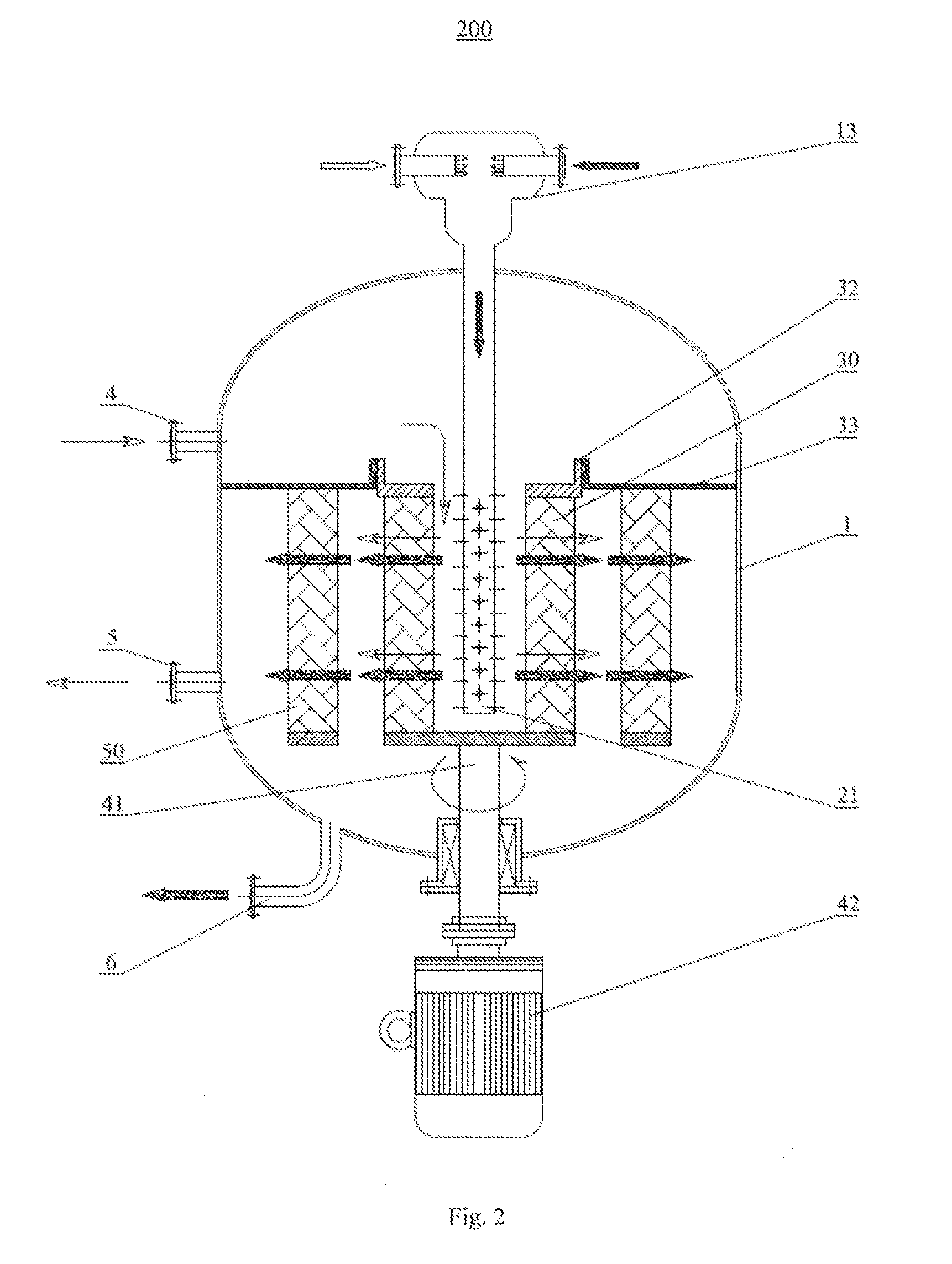Reactor and Alkylation Process Using the Reactor
a reactor and alkylation technology, applied in the field of reactors, can solve the problems of less effective reaction, and achieve the effects of improving product quality, reducing reaction temperature, and improving contact efficiency of catalysts and hydrocarbon reactants
- Summary
- Abstract
- Description
- Claims
- Application Information
AI Technical Summary
Benefits of technology
Problems solved by technology
Method used
Image
Examples
examples 1 to 3
[0055]The reactor 100 as indicated in FIG. 1 is adopted. The rotating bed layers comprise stainless steel mesh fillers and the bed voidage thereof is 0.95, the specific surface area is 4,000 m2 / m3 and the wire diameter is 1 mm. The volume of the rotating bed layers accounts for 45% of the total volume within the reactor housing. The stationary bed layers adopt the same wire fillers as the rotating bed layers and are 50% as thick as the rotating bed layers. Concentrated sulfuric acid of 95% by mass is used as the catalyst and isobutane and butene are used as raw materials to carry out the alkylation reaction.
[0056]The molar ratio of isobutane to butene is in a range from 1:1 to 300:1, preferably from 3:1 to 50:1. The volume ratio of acid to hydrocarbon is in a range from 0.1:1 to 5:1, preferably from 0.5:1 to 1.5:1. The reaction temperature ranges from −20 to 15° C., preferably from −10 to 10° C. and more preferably from −5 to 5° C. The reaction pressure ranges from 0.2 to 1.5 MPa, p...
examples 4 to 6
[0061]The reactor 200 as indicated in FIG. 2 is adopted. The rotating bed layers comprise stainless steel mesh fillers and the bed voidage thereof is 0.95, the specific surface area is 4,000 m2 / m3 and the wire diameter is 1 mm. The volume of the rotating bed layers accounts for 65% of the total volume within the reactor housing. Concentrated sulfuric acid of 95% by mass is used as the catalyst and isobutane and butene are used as raw materials to carry out the alkylation reaction.
[0062]The molar ratio of isobutane to butene is in a range from 1:1 to 300:1, preferably from 3:1 to 50:1. The volume ratio of acid to hydrocarbon is in a range from 0.1:1 to 5:1, preferably from 0.5:1 to 1.5:1. The reaction temperature ranges from −20 to 15° C., preferably from −10 to 10° C. and more preferably from −5 to 5° C. The reaction pressure ranges from 0.2 to 1.5 MPa, preferably from 0.3 to 0.8 MPa. The rotating bed rotates at a speed in a range from 50 to 5,000 rpm, preferably from 150 to 2,000 r...
PUM
| Property | Measurement | Unit |
|---|---|---|
| pressure | aaaaa | aaaaa |
| pressure | aaaaa | aaaaa |
| temperature | aaaaa | aaaaa |
Abstract
Description
Claims
Application Information
 Login to View More
Login to View More - R&D
- Intellectual Property
- Life Sciences
- Materials
- Tech Scout
- Unparalleled Data Quality
- Higher Quality Content
- 60% Fewer Hallucinations
Browse by: Latest US Patents, China's latest patents, Technical Efficacy Thesaurus, Application Domain, Technology Topic, Popular Technical Reports.
© 2025 PatSnap. All rights reserved.Legal|Privacy policy|Modern Slavery Act Transparency Statement|Sitemap|About US| Contact US: help@patsnap.com


